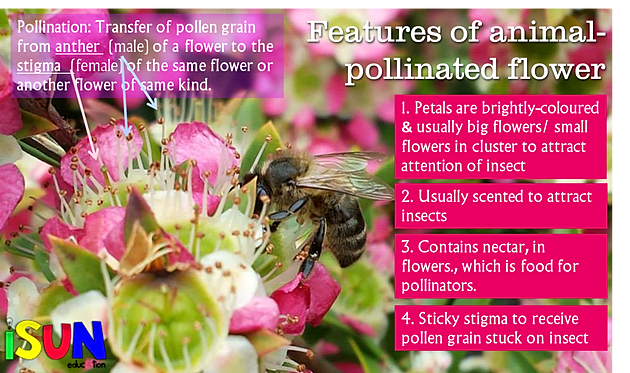Topic: P5 Science (Reproduction of Flowering Plants with Modified 2013 PSLE Science Question)
For flowering plants, pollination and fertilisation need to take place in flowers before flower can bear into fruits.
Pollination is the transfer of pollen grains from anther of a flower to the stigma of the same flower or a different flower of the same kind.
Anther is the MALE part of the flower that produces and stores pollen grains.
Stigma is the FEMALE part of the flower that receives pollen grains.
(stigma can be remembered as sticky mama :P)
Pollination can be carried out with the help of wind or animals including insects or birds. Generally these animals feed on nectar in the flower.
Animals-pollinated flowers generally have the following features:
- Brightly colour petals to attract animals
- Big flowers or small cluster flowers to attract animals
- Scented flowers to attract animals
- Have nectar to attract animals
- Anthers usually does not hang out of flower to brush against insect
- Sticky pollen grains to stick on animals
- Sticky stigma to receive pollen grain from animals
As seen from the above, the plant put in a lot of effort to 'grow' the flowers.
Examples of such flowers include hibiscus, ixora, morning glory and many others.
Modified PSLE Science Question 2013
Characteristics of Flower F
- Gives off a strong rotting meat smell
- Does not produce nectar
- Male and female parts are found on different flower
Characteristic of insect G
- Attracts by the smell of Flower F
- Lavrva of Insect G feeds on rotting meat
Suggest a reason why Insect G is attracted to the smell of Flower F? (1m)
Answer: It is because Insect G thought that flower F is food, thus it is attracted to smell of Flower F
Explanation: It is similar to bees visiting sweet-scented flowers for nectar to feed on.
What is the role of Insect G? (1m)
Answer: Insect G acts as a pollinator to transfer pollen grain from the anther of the male flower to thestigma of another female flower.
Explanation: Flowers can be wind-pollinated or animal-pollinated.
Since the question here did not mention anything about wind, high likely it is pollinated by animal and in here it is insect G,
0.5m for Pollinator, 0.5m for definition of pollination.
*** NOTE ****

This comment has been removed by the author.
ReplyDeletegood job. keep it up.
ReplyDeletePsle math tuition
psle science tuition
psle english tuition
psle science tuition in singapore
psle english tuition in singapore
Thanks for the explanation, learn more about Animal-Pollinated Flower with the support of science tuition and choose the best PSLE tuition for learning
ReplyDeleteDo you know how fast the demand for IB online tuition is increasing in today's time? If you really want to excel in your studies on the IB board and want to make your parents feel proud, then book an online class for IB Board with the best online tutors of Ziyyara.
ReplyDeleteCall Us For Free Demo:- +91 9654271931
Get Free Demo:- https://ziyyara.in/ad-contact
ReplyDeleteThanks For sharing this wonderful blog.
Ziyyara is a platform which provides ibdp tutor and ib courses or call +91-9654271931 for more information.